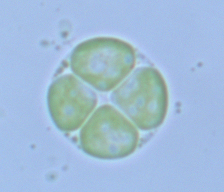1 Fang SC, de los Reyes C, Umen JG (2006). Cell size checkpoint control by the retinoblastoma tumor suppressor pathway. PLoS Genet 2, e167.
2 Galbraith DW, Harkins KR, Maddox JM, Ayres NM, Sharma DP, Firoozabady E (1983). Rapid flow cytometric analysis of the cell cycle in intact plant tissues. Science 220, 1049-1051.
3 Gorman DS, Levine RP (1965). Cytochrome f and plastocyanin: their sequence in the photosynthetic electron transport chain of Chlamydomonas reinhardi . Proc Natl Acad Sci USA 54, 1665-1669.
4 Harris EH (1989). The Chlamydomonas Sourcebook . San Diego: Academic Press. pp. 25-63.
5 Harris EH (2001). Chlamydomonas as a model organism. Annu Rev Plant Physiol Plant Mol Biol 52, 363-406.
6 Kumagai-Sano F, Hayashi T, Sano T, Hasezawa S (2006). Cell cycle synchronization of tobacco BY-2 cells. Nat Protoc 1, 2621-2627.
7 Lemaire S, Hours M, Gerard-Hirne C, Trouabal A, Roche O, Jacquot JP (1999). Analysis of light/dark synchronization of cell-wall-less Chlamydomonas reinhardtii ( Chlorophyta ) cells by flow cytometry. Eur J Phycol 34, 279-286.
8 Leu S, White D, Michaels A (1990). Cell cycle-dependent transcriptional and post-transcriptional regulation of chloroplast gene expression in Chlamydomonas reinhard- tii . Biochim Biophys Acta 1049, 311-317.
9 Matsuo T, Ishiura M (2011). Chlamydomonas reinhardtii as a new model system for studying the molecular basis of the circadian clock. FEBS Lett 585, 1495-1502.
10 Matsuo T, Okamoto K, Onai K, Niwa Y, Shimogawara K, Ishiura M (2008). A systematic forward genetic analysis identified components of the Chlamydomonas circadian system. Genes Dev 22, 918-930.
11 Matters GL, Beale SI (1994). Structure and light-regulated expression of the gsa gene encoding the chlorophyll biosynthetic enzyme, glutamate 1-semialdehyde aminotrans- ferase, in Chlamydomonas reinhardtii. Plant Mol Biol 24, 617-629.
12 Menges M, Murray JA (2002). Synchronous Arabidopsis suspension cultures for analysis of cell-cycle gene activity. Plant J 30, 203-212.
13 Merchant SS, Prochnik SE, Vallon O, Harris EH, Karpowicz SJ, Witman GB, Terry A, Salamov A, Fritz-Laylin LK, Marechal-Drouard L, Marshall WF, Qu LH, Nelson DR, Sanderfoot AA, Spalding MH, Kapitonov VV, Ren Q, Ferris P, Lindquist E, Shapiro H, Lucas SM, Grimwood J, Schmutz J, Cardol P, Cerutti H, Chanfreau G, Chen CL, Cognat V, Croft MT, Dent R, Dutcher S, Fernandez E, Fukuzawa H, Gonzalez- Ballester D, Gonzalez-Halphen D, Hallmann A, Hanikenne M, Hippler M, Inwood W, Jabbari K, Kalanon M, Kuras R, Lefebvre PA, Lemaire SD, Lobanov AV, Lohr M, Manuell A, Meier I, Mets L, Mittag M, Mittelmeier T, Moroney JV, Moseley J, Napoli C, Nedelcu AM, Niyogi K, Novoselov SV, Paulsen IT, Pazour G, Purton S, Ral JP, Riano-Pachon DM, Riekhof W, Rymarquis L, Schroda M, Stern D, Umen J, Willows R, Wilson N, Zimmer SL, Allmer J, Balk J, Bisova K, Chen CJ, Elias M, Gendler K, Hauser C, Lamb MR, Ledford H, Long JC, Minagawa J, Page MD, Pan J, Pootakham W, Roje S, Rose A, Stahlberg E, Terauchi AM, Yang P, Ball S, Bowler C, Dieckmann CL, Gladyshev VN, Green P, Jorgensen R, Mayfield S, Mueller-Roeber B, Rajamani S, Sayre RT, Brokstein P, Dubchak I, Goodstein D, Hornick L, Huang YW, Jhaveri J, Luo Y, Martinez D, Ngau WC, Otillar B, Poliakov A, Porter A, Szajkowski L, Werner G, Zhou K, Grigoriev IV, Rokhsar DS, Grossman AR (2007). The Chlamydomonas genome reveals the evolution of key animal and plant functions. Science 318, 245-250.
14 Michaels A, Herrin DL (1990). Translational regulation of chloroplast gene expression during the light-dark cell cycle of Chlamydomonas : evidence for control by ATP/energy supply. Biochem Biophys Res Commun 170, 1082-1088.
15 Mitchell MC, Meyer MT, Griffiths H (2014). Dynamics of carbon-concentrating mechanism induction and protein relocalization during the dark-to-light transition in synchronized Chlamydomonas reinhardtii . Plant Physiol 166, 1073-1082.
16 Miyagishima SY, Suzuki K, Okazaki K, Kabeya Y (2012). Expression of the nucleus-encoded chloroplast division genes and proteins regulated by the algal cell cycle. Mol Biol Evol 29, 2957-2970.
17 Tirumani S, Kokkanti M, Chaudhari V, Shukla M, Rao BJ (2014). Regulation of CCM genes in Chlamydomonas reinhardtii during conditions of light-dark cycles in synchronous cultures. Plant Mol Biol 85, 277-286.
18 Umen JG, Goodenough UW (2001). Control of cell division by a retinoblastoma protein homolog in Chlamydomonas . Genes Dev 15, 1652-1661.
19 Werner R (2002). Chlamydomonas reinhardtii as a unicellular model for circadian rhythm analysis. Chronobiol Int 19, 325-343.
20 Yamano T, Iguchi H, Fukuzawa H (2013). Rapid transformation of Chlamydomonas reinhardtii without cell-wall removal. J Biosci Bioeng 115, 691-694.


